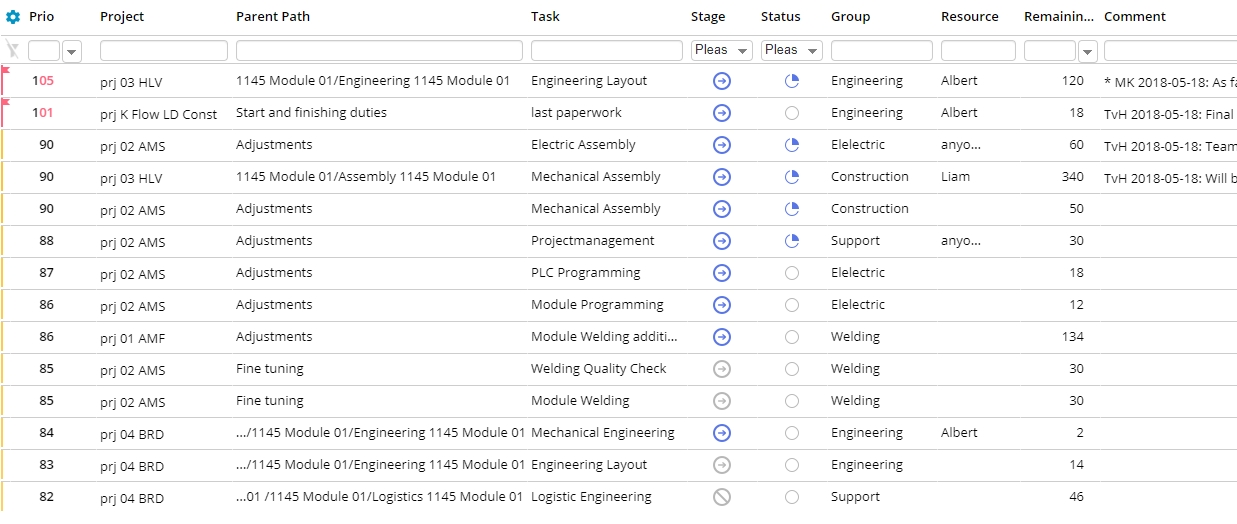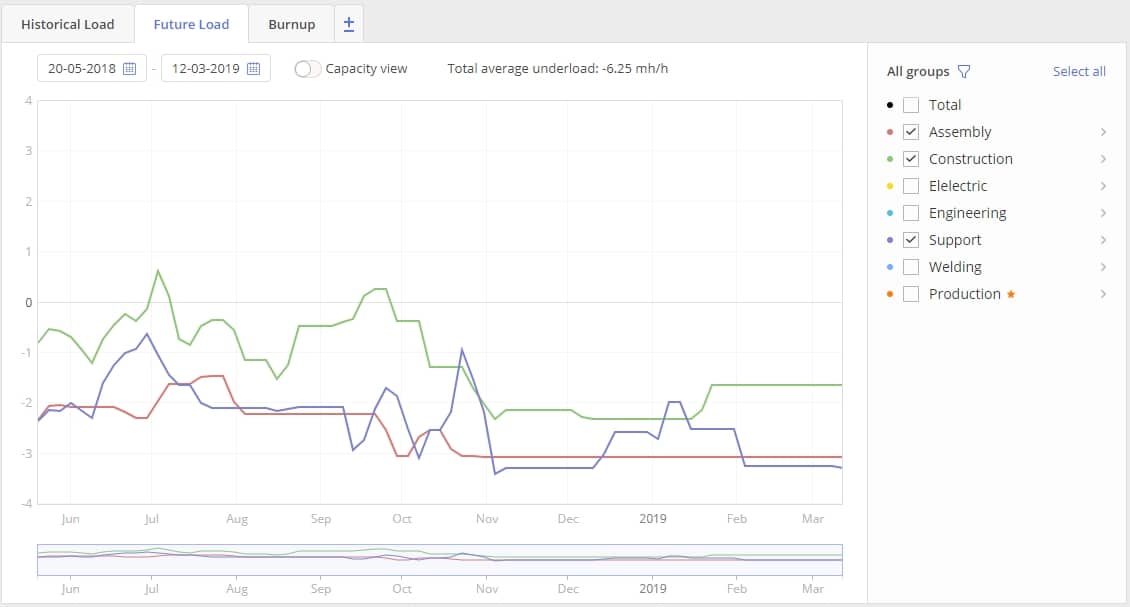Imagine that you ask your team members to slow down instead of work faster. Sounds strange, doesn’t it? In the dynamic multi-project environment, it seems that the more productive you are and the faster you deliver, the better. However, statistics shows that the majority of employees have experienced burnout at work at least once. Such reality poses one more challenge for project managers: how to deliver a project successfully and prevent the team from overload at the same time.
What Causes Overload?
There are a great number of factors that lead to employees’ overload. Leaving aside the ones that are on an employee’s responsibility, we will mention the factors that can be eliminated due to proper work organization: lack of prioritization and unrealistic expectations.
It seems that it’s impossible to avoid multitasking in multi-project environment as long as employees often work on multiple projects at the same time. However, lack of prioritization leads to bad multitasking when an employee gets distracted by multiple tasks and actually delivers nothing. On top of that, a pile of unaccomplished tasks causes additional stress, which doesn’t add to high productivity, and it may seem that you have to work longer hours to cope with all these tasks.
Setting unrealistic expectations is the other reason that can lead to employees’ overwork. Lack of thorough planning, ineffective communication with the project team lead to misunderstandings, lack of clarity concerning the task execution, which are likely to cause high stress. Unrealistic deadlines are worth special attention here as long as they not only force employees to work more, but also to work under pressure of time. Haste makes waste, so the quality of the work delivered under these conditions is questionable.
Read more: Dealing with Unrealistic Expectations in Project Management
Consequences of Overload

Obviously, overload leaves its mark on team members’ physical and mental health, and affects their performance. Let’s take a look at its consequences.
- Problems with physical health
Employees who work long hours and/or at a quick pace tend to experience high levels of stress, which together with sedentary lifestyle results in sleep disorders, fatigue, and, according to the Harvard Health Publishing, higher risks of heart attack, stroke, and diabetes. In addition, an employee’s health may be affected by bad habits and comfort eating, which are constant companions of long-term stress. Consequently, if team members are always in a hurry and under stress, it creates additional risks, as one them may fall ill all of a sudden.
- Burnout
Emotional burnout is a dangerous state of physical and emotional exhaustion which is the result of experiencing long-term stress. The symptoms of burnout are often ignored and attributed to ordinary stress, but this only makes matters worse. There are three groups of burnout symptoms: exhaustion (a person is always tired, unable to cope, has some health problems), alienation from work (employees may start being cynical about their work or distance themselves from the rest of the team) and reduced performance (an employee tends to miss deadlines, procrastinate or finds it difficult to concentrate).
- Reduced productivity
Apart from physical and mental health issues, overloaded employees tend to become disengaged about the work they are doing, may lose their motivation or satisfaction from their achievements, and lack initiative. Also, there is a high probability of making more mistakes due to concentration difficulties. Consequently, overload reduces employees’ productivity.
Needless to say that you won’t succeed with your project with overloaded team members, so it’s the project/resource manager’s responsibility to organize work in such a way that the team members won’t have to work faster or long hours.
Read more: How to Distinguish Between Stress and Burnout and Cope with Them: Tips for Project Managers
Tips for Project and Resource Managers on Preventing Employees from Overload
While working on a project, it’s critically important for the team members to have enough energy and enthusiasm to cope with their tasks. Below are the actions that should be taken by project managers to prevent the team members from overload.
Enhanced Planning

It’s impossible to overestimate the importance of detailed planning, as it will enable you to avoid a variety of possible bottlenecks, including overloaded employees. Project planning covers all the aspects needed for successful project implementation: established goals, deliverables and delivery dates; task dependencies; possible risks, in other words – all the activities and tasks required in the appropriate order and workflow. Project planning as a whole involves developing a set of smaller plans (e.g. scope planning, resource planning, risk management plan) that guide the team members through the project implementation.
What are the benefits of project planning that can prevent employees from overload?
- Firstly, the stage of planning involves setting realistic expectations and deadlines depending on resources’ capacity.
- Secondly, every project participant can have a clear understanding of the whole process of project implementation.
- Thirdly, assessment of potential risk factors makes unexpected situations that may arise quite manageable.
- Fourthly, planning facilitates communication between all the parties involved in the project, which in turn reduces misunderstandings.
All of these advantages aim to provide employees with clarity concerning the project workflow, which means that the level of stress and the amount of wasted time will reduce significantly.
In addition, there are a variety of opportunities provided by project management software tools. For example, with Epicflow multi-project management software, it’s nearly impossible to make poor planning, as the system forces users to follow a certain protocol to ensure that project plans are executable and valid.
Task Prioritization
As it has been mentioned above, one of the reasons causing stress at work is a lack of prioritization, which usually results in bad multitasking. Being busy and working too much is not the same as being efficient. Knowing the highest priority task and working on it is the key to employee’s productivity and overall project success. There are some techniques that help with prioritization, e.g. Pareto Principle also known as “80/20 Rule”, which means that 80% of the result is determined by 20% of efforts. In other words, 20% of high priority tasks determine 80% of project success.

Epicflow provides huge opportunities for managing project tasks. For example, Task List automatically orders them according to their priority. So, you won’t have to choose any prioritization techniques, as the system will have it done for you. And what is the most significant, the team members will remain focused on the most important tasks, which will enable them to reach objectives faster, avoid missed deadlines and reduce stress resulting from bad multitasking and overload.
Proper Resource Management
Resource management techniques are focused on work optimization and increasing employees’ productivity. They are particularly important if the team members have to perform concurrent tasks or work on multiple projects simultaneously. One of their benefits is preventing team members from overwork and burnout by means of effective allocation of the available resources and using them to their maximum potential. Therefore, appropriate resource management techniques reduce the possibility of overloading team members, and if that happens, they will help you find an employee with necessary skills in the other group so that the project tasks will be completed on time.
Read more: How to Handle the Issue of Slow Recruitment with Resource Management Techniques
And, of course, the opportunities of project management software shouldn’t be ignored: Epicflow makes it possible to manage your resources and their load in the most efficient way.
Competence Management enables project/resource managers to add and change competences and attribute them to corresponding resources. Also, it’s possible to mark the level at which skills are developed, so when you are going to assign a task to a certain resource, you can see the level of their competences. If there is a perfect match for executing the task, it is marked with the green color. Due to the Competence Filtering option you can see all the users in the system who have necessary skills to complete the task. Finally, the Batteries option makes it possible to see an employee’s capacity for the required dates, which is calculated automatically, and marked with green, yellow, and red colors indicating those who have capacity to do the task, have some capacity or have no capacity correspondingly.

Future Load aims to predict potential bottlenecks like a lack of resources or their overload in the future so that project managers can take necessary actions. Also, you can see, which of the groups will be idle in the future, and in case someone from this group has necessary skills, they may help the overloaded group, so there won’t be any delays, and the team members won’t be overworked. Finally, the Future Load Graph shows what maximum amount of output each group is capable of producing, which is measured in man-hours per hour, so that project managers become aware of the actual capacity of the team members.
Thus, being armed with these software tools, project managers can manage the available resources in the most efficient way, and overloading team members will be next to impossible.
As a conclusion, we’d like to note that you don’t have to deliver projects at any price anymore, as long as smart project/resource management tools and techniques enable you to deliver faster with less effort. Let us know if you’d like Epicflow to be your guide to more efficient project management.

